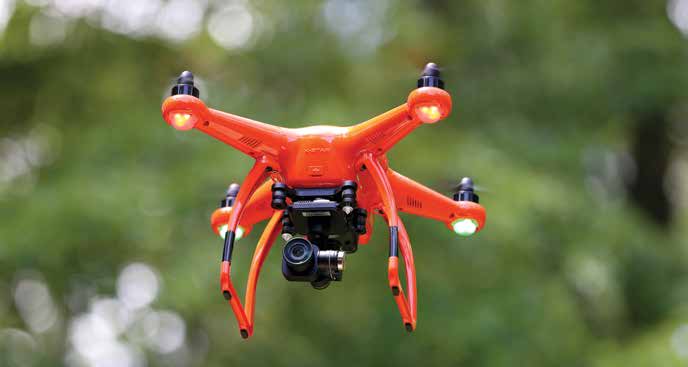

SVC: Tell us about Elliott Visuals. It’s in Olney, Maryland and that’s about twenty miles north of Washington—an area where they get pretty nervous about drones.
Bob Elliott: Yes. Everybody gets nervous about drones, but particularly people at our capital. We’ve been around since 1988. I fly an Autel. It’s one that is manufactured here in the United States.
There are a lot of people getting into drones, but the commercial aspects are, you might say, just taking off.
It is taking off. I equate it to the car versus the horse and buggy. Everybody is kind of looking at it and trying to define the rules of engagement and it changes every day. Trust me on that one.
The drones run all the way from tiny hand-sized ones all the way to the ones made by Hollywood film companies. They come up with some pretty fancy machines.
Hollywood will usually build their own drone out of carbon fiber and it takes weeks and months to build and lots of batteries and lots of motors and propellers. And usually they have FAA certification to fly and they tell them what they’re shooting and filming and off they go. But they’re actually the vast minority. The vast majority are anywhere between $100.00 and $500.00 drones—that’s for propellers and the motor—and people just buy them on Amazon and go flying.
Among the growing uses for drones is AV camera platforms. So if you’re going to invest in one of these things with that idea in mind, what are some of the concerns?
Well, you know, when you’re in AV, when you’re dealing with indoor venues, a lot of times FAA isn’t concerned, but of course he FCC is very concerned. You can legally fly inside, but you have to deal with production companies and producers and clients and sometimes they really don’t like things flying over their heads. It’s pretty much up to the remote pilot to convince the powers that be inside of a ballroom or convention center that what they’re about to do is safe and never fly over a crowd. It’s always best before doors open—like a photographer. Just clear the way, let me get some shots, and then you can open the doors.
One of the many things I’ve seen advertised for drones is the duration of flight time and how long it can operate on one battery charge.
Correct. In the drone world, typically 20 minutes is the average time a drone will stay airborne. When you’re dealing with outside venues, you have to deal with wind and height. That determines how easily you can get the drone back. Inside, with no wind or storms (hopefully) it might have a longer flight time.
I’ve heard that you should make sure the first one you buy is a cheap one, at least in the price range of something that you’re willing to lose in the process of learning to fly it.
That’s correct. It’s kind of like gambling. Don’t gamble unless you’re willing to lose. So my first two drones were $100.00 and $50.00. I learned real quick about what it can and can’t do. They both flew away on their own recognizance. I have yet to find them— we call that a fly-away in the drone world. When I purchased my first $1,000.00-plus drone, at least I knew how to respect it.
There must be quite a variance on the engines that you can get for these things.
Yeah. The little ones have what they call brushed motors—I’m not an engineer or a physicist, but when you get up towards the larger drones it’s brushless motors which last a heck of a long time. Usually those are attached to what we call a LiPo battery. It’s a lithium polymer battery. They have a tendency to give you a lot of energy really quickly but they’re not very stable. They’re rechargeable. You have to watch them. Can’t leave them alone.
When most people think about drones, they’re imagining quadcopters and optocopters, but there are actually some fixed-wing drones, too.
There are. Autel makes one. It’s not a big consideration for AV because a lot of AV takes place inside, so flying something with a fixed wing, whether it’s an electric or gas motor may or may not work. For the most part when people say drone they think of a quadcopter, four propellers or more.
So if the engine quits at least it’s not going to come crashing straight down if you still have an RF connection to the controls.
Most assuredly. You see a lot of videos on YouTube about coming down. Very interesting. YouTube is a fascinating place to see the footage of what respectable—or unrespectable—drone operators do with their drones.
When you’re flying outside, it’s probably not uncommon to have them shot at or even attacked by birds.
I deal with birds and other flying objects all the time whether they’re bees or wasps or hummingbirds or larger birds. They see me flying my orange pumpkin, which us Autel people lovingly call our drone. It’s an attraction. Blue jays and hawks look at this thing and they don’t know what to do with it. So not only do you have to look out for aircraft, you have to look out for the biologicals as well.
On the legal side there are new aspects every day.
The law is always there waiting. It’s incredible. The drone realm and the legal realm are always shaking hands whether they really want to or not. I have a legal counsel and I have insurance. I have to carry liability insurance. I carry drone equipment insurance. One of the things I do a lot for my clients to put them at ease is I go to Verifly, which is an app that lets you buy insurance for that time you are using the drone. You buy it and you print it, or you show them the phone, and it’s all good and off you go making money. It’s a good thing.
Now that’s an unusual concept. There is insurance for airplane owners that covers the plane only while it’s on the ground, and other policies that begin coverage as soon as you add power for takeoff, but I’ve never heard of the type that only covers you as the operator for a specific flight.

Yes, they cover you by the flight, by the time, by the hour, and by what you’re doing. They offer up to $2.5 million of insurance for an hour and it’s very cost effective. It’s $20.00, $30.00, $35.00 depending on what you do and how much insurance you want to show for it. As long as you don’t fly above people, knock yourself out. The client is always appreciative that you carry these things.
Another thing that I found interesting on the legal aspect of it is that there are different regulations for operating tethered drones as opposed to those on free-flying models.
A long time ago I used to have a little Cessna RC-controlled plane. It was tethered. The string broke and my little Cessna gaspowered plane flew away and I never heard from it again—nor anybody else. It’s very difficult to tether a drone. You have to also prove that it’s not going to fly away and you always have to have a back-up tether. If you only have one primary tether, that may or may not give you the insurance coverage you need. You need to show that it’s doubly insured with two tethers.
When drone people have an event, how is the RF coordination done? That must be a big job.
A lot of the time when I get drone enthusiasts together everything is flown on Wi-Fi, which is 2.4 to 5.8 gigahertz, so 32 channels. It has a tendency to make some people’s job a little bit more primary than others. If you’ve ever been to a drone event, there’s always somebody who’s not listening—they’re concerned about something else—and they turn on their drone that happens to be on the same channel as somebody else and it falls out of the sky. Multiple times I’ve seen drones looking for drones at these events. So, be sure that you chime in with the person who’s in charge of frequencies before you turn that thing on.
One of the most widely-advertised features that I’ve seen on drones is the ability for it to autonomously go to a specific GPS location if you lose RF communication with it.
Not so much the racing drones, but with my drone and some of the DJI drones, you can set what they call a home point where you want the drone to land. But in general, a drone doesn’t know where it is or what it’s doing. So I usually keep a 200-foot ceiling which gets me above most power lines and trees. That way if I ever lose contact with my drone, it’s going to go up to 200 feet and make an L at 200 feet to the home point. It’s been safe so far.
What sort of video footage do you shoot with your drone?
Inside footage for AV is typically getting shots on set, maybe doing an intro for a vice president or president of a company. Those are usually what we call B roll. Very rarely do we shoot A roll inside of a live venue because there are way too many concerns about what’s going to happen, especially when everybody taps onto their phone. Or if there’s Wi-Fi in the house, that’s going to interrupt our signal.
What sort of features have you found especially useful for a drone in the AV?
I can put it on ATTI mode, which is attitude mode, so I could fly inside and get some really dramatic footage. But you have to be an expert at flying this thing. You can’t just turn it on and think it’s going to do something, because it doesn’t know where it’s at. It doesn’t know what ballroom or convention or city. Also, certain drones, depending on your budget, won’t operate very well inside. DJI drones and Autel drones will have forward, ground, and sometimes even rear-firing sonar or radar so it knows where the walls are, the floors are, the ceilings are so you can photograph a little bit better inside.
Are there major differences between the control devices and how quickly you can learn those?
I started up with Hubsan drones. They’re quick to learn on. There are drones in the $50.00-$100.00 range that you can practice on. I wouldn’t practice inside. When you’re willing to step up to the game and invest some money, you get an Autel or DJI, which will range from $1,000.00-$5,000.00. I like my Autel because if for some reason my phone or my laptop or my Kindle or whatever I’m flying it doesn’t work, I can still fly my drone. It’s difficult to do that with the DJI drone because they connect to the phone or the Wi-Fi in the area, which then has a tendency to confuse things, especially inside.
Aren’t there devices out there now that can simulate a GPS signal and commandeer your drone and crash it or just fly it away.
Once you’re dealing with signal and code and ones and zeros, if anybody has any aptitude or the willingness to do something that is a little bit unsavory, they will. You can hack into anything. So it’s a predicament for a small percentage, but it’s still out there. And Autel has a way of dealing with things, DJI has a way of dealing with things. For the most part the GPS will tell you what you’re doing with your drone, but Wi-Fi tells your drone what to do. So it’s two different signals.
So it’s measures and countermeasures.
Most assuredly. The police—and it doesn’t matter where you are in the world –will either shoot a Wi-Fi signal at your drone, or a net. France has birds of prey that attack drones. If you’re above board and you’re doing things correctly, you’re the least likely to be intercepted by countermeasures. If you’re just being a yahoo flying around getting crazy footage you’re more susceptible to the law enforcement agency putting the kibosh on you.









